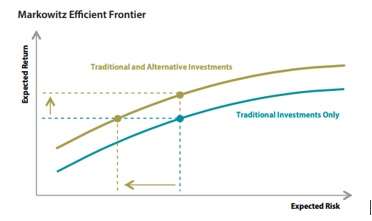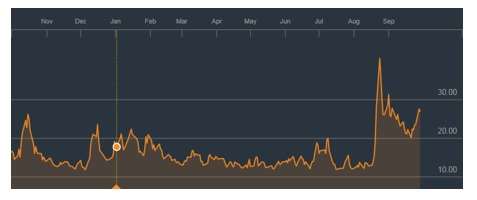 By Diane Harrison
By Diane Harrison
Advisers are gearing up for year-end allocation reviews with clients, and once again, dreading the inevitable push-back from some over increasing or holding steady on alternative investments. Last year, while the S&P 500 returned north of 13%, the hedge fund index universe averaged between 2.5 – 6.1%, adding to the pressure for advisers to keep their clients committed to alternatives.
Why is it so hard for investors to accept that alternative investments are supposed to behave differently than traditional investments? When presented with the argument for including alternatives in a total portfolio, most investors are hypothetically fine with the potential return streams offered by such investments diverging from the traditional stocks and bonds paths. When both alternatives and traditional markets are on the upswing, investors don’t appear to second guess the directions their investments are taking. But, when the paths separate, and alternatives are on the downswing, or merely lagging the upward trend of traditional markets, suddenly the whole concept of having alternatives within a portfolio is up for discussion. While the following seems rather basic, much like athletes practicing their sport for hours to build muscle memory, these points can reinforce advisers’ persuasive mental memory of the role alternatives play in clients’ portfolios.
THE UPSIDE OF MINIMIZING THE DOWNSIDE
Alternatives can provide diversification and overall reduction in risk and volatility. That’s the crux of why they are recommended to improve portfolio allocation. There are reams of research synopsis and charts available showing that over the long-term, the addition of alternatives can add value and smooth volatility.

Graph courtesy of Baird research – not to scale.
Yet when traditional markets are doing well while alternatives markets are doing less so, investors will ask their advisers to trim exposure to alternatives, typically at the most inopportune times, when staying the course would be their most prudent decision. They will say, “Perhaps these things don’t really help me? Maybe I should just redeem before the situation gets worse and I “give up” more of the traditional markets’ gains?” Advisers have had a tough time combating this common investor concern. When alternatives markets are compared to a sustained bull market phase in equities, the number of unhappy investors rises in proportion to the lag in performance of the alternatives returns. Advisers need support in helping their clients to focus on the benefits of holding alternatives in their portfolios before the dissatisfaction factor clouds the client’s ability to hear them.
VOLATILITY CAN BE A GOOD THING…IF YOU CAN TAKE ADVANTAGE OF IT
Most investors have been conditioned to fear volatility and avoid it as much as possible, a good plan in traditional markets. Conversely, many alternatives managers have designed specific strategies to take advantage of and exploit volatility in their market approach. As the chart below shows, volatility is on the rise since Augusts’ dramatic spike, and maintaining higher levels than at any point this year.
Source: Bloomberg.com, Chicago Board Options Exchange SPX Volatility Index
By weaving in alternatives that can capture the upside and mitigate the downside inherent in market volatility, investors can improve their overall portfolio risk profile…assuming they stay the course and don’t decrease their allocation to these alternatives. Advisers need to stay vigilant with their clients through all market cycles about communicating the benefits of forgoing a little upside occasionally to protect against sharper downsides in overall portfolio allocations.
ALTERNATIVES ARE NON-CORRELATED WITH TRADITIONAL MARKETS.
Theory sounds fine when advisers explain how to mix in alternatives to create a stronger, more balanced portfolio. The reality is a harder sell to clients when alternatives are in the red zone and stocks are still rising. To the endless frustration of advisers and alternatives managers, clients seem to turn a deaf ear to the logic that a long/short portfolio should lag in performance over a long-only portfolio when markets are rising. Equally frustrating is when clients don’t seem to accept that commodities, or managed futures, are generally moving differently from equities, and are supposed to do so. The unnatural equities and bond markets of the past several years, controlled and driven more by central banks than by economic principles, have added to this investor fallacy that rising markets should carry all boats higher.
TAKING THE LONG VIEW
Alternatives, like traditional investments, are meant to be evaluated through a full market cycle. Portfolios are built to withstand market risks and perform over the long haul, through anticipated and unanticipated market movements. Diversification is a concept almost all investors accept readily as a sound financial goal…until the alternatives slice of their portfolio is in decline, and they fall prey to the desire to trim the loss and pile on the traditional portions that are outperforming. Unless a client is a short-term trading specialist, advisers need to reinforce the concept of avoiding market timing across all categories of allocation, especially when volatility is on the rise.
PROTECTING THE DOWNSIDE IS MORE CRITICAL THAN RIDING EVERY UPSIDE
Most wealthy individuals already subscribe to the “stay rich” mentality of conservative investing. Individuals who want to get rich would be wise to emulate a similar, long-range view on building wealth through solid diversification of assets combined with a stable, well-protected risk management process that allows for growth as well as limited downside exposure. Pairing up with managers, both traditional and alternative, who share in this long-range view, will contribute to peace of mind, clearer vision though market dips and pops, and a stronger portfolio. Advisers should have these conversations with their clients frequently, and not just annually, to reinforce this goal through all market phases, and help their clients remember what sold them on the process originally.
Diane Harrison is principal and owner of Panegyric Marketing, a strategic marketing communications firm founded in 2002 and specializing in a wide range of writing services within the alternative assets sector. She has over 20 years’ of expertise in hedge fund marketing, investor relations, sales collateral, and a variety of thought leadership deliverables. In 2015, Panegyric Marketing received AI’s awards for Best Financial Services Marketing & Communications Firm, Innovation in Asset Strategy, and Business Excellence in Strategy & Positioning Statements – USA as well as M&A's Excellence in Financial Services Marketing – USA, and Best Financial Marketing Firm - USA. The firm also won consecutive year awards in 2013-14 as IHFA’s Innovative Marketing Firm of the Year and AI’s Marketing Communications Firm of the Year- USA. A published author and speaker, Ms. Harrison’s work has appeared in many industry publications, both in print and on-line. dharrison@panegyricmarketing.com





